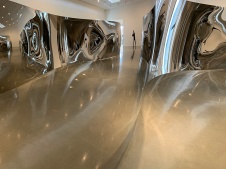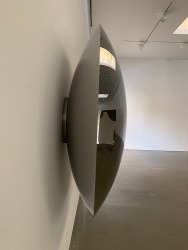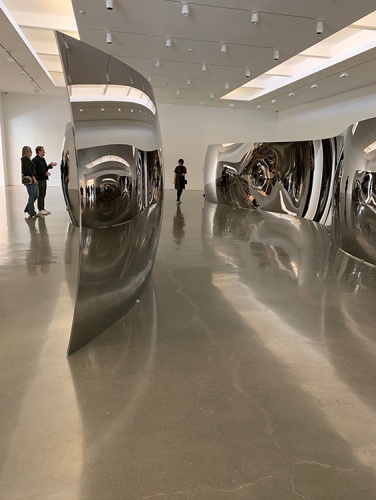Anish Kapoor at Regen Projects

Reflections Upon Reflections
Regen Projects, Los Angeles
through February 16
through February 16
Written By Lorraine Heitzman
Anish Kapoor cleverly exploits the variable qualities of reflections in his mesmerizing new show at Regen Projects. The installation of impeccably crafted stainless-steel sculptures creates and destroys perceptions about our corporeal selves and the spaces we occupy, vacillating between the real and unreal. Kapoor understands the power that reflections have in their ability to mimic or contort reality and he artfully manipulates convex and concave surfaces to maximize these effects and distortions. Reflections can amuse us, as they do in funhouse mirrors, or conversely, they can confuse, like in the shattering climax of Orson Welles’ The Lady From Shanghai. The myth of Narcissus illustrates how reflections may stoke our vanity, and they also speak back to us, as in Snow White. In other words, reflections coax and reveal many aspects of our humanity from the mundane to the mysterious.
Anish Kapoor cleverly exploits the variable qualities of reflections in his mesmerizing new show at Regen Projects. The installation of impeccably crafted stainless-steel sculptures creates and destroys perceptions about our corporeal selves and the spaces we occupy, vacillating between the real and unreal. Kapoor understands the power that reflections have in their ability to mimic or contort reality and he artfully manipulates convex and concave surfaces to maximize these effects and distortions. Reflections can amuse us, as they do in funhouse mirrors, or conversely, they can confuse, like in the shattering climax of Orson Welles’ The Lady From Shanghai. The myth of Narcissus illustrates how reflections may stoke our vanity, and they also speak back to us, as in Snow White. In other words, reflections coax and reveal many aspects of our humanity from the mundane to the mysterious.
The main gallery is dominated by “Double S-Curve”, two Richard Serra-esque undulating, free-standing walls. Rather than the slightly menacing COR-TEN steel and grounded earthiness of Serra’s work, Kapoor’s installation is ephemeral and conceptual. Fabricated from stainless-steel and polished to a flawless sheen, the sculpture sits on the gallery floor, but feels light and amorphous. The initial and overwhelming effect is one of disorientation, a feeling that induces a lightheadedness. Your sense of self and space evaporates as you move between the mirrored surfaces, reminiscent of the heady feeling one has when trying out new lenses. In much the same way, your accustomed vision is gone and replaced with a different perspective. The experience is not unpleasant, though. The reflections reverberate in organic shapes against their mirrored surfaces and the mutations are amusing and fascinating, not dissimilar to the responses to the artist’s Cloud Gate in Chicago, (affectionately dubbed “The Bean”). We love images of ourselves and these mirrored sculptures give us ample opportunities to engage with our reflections while we question the reality of what we see. Kapoor delights his audience with the skills of an accomplished showman, though it is more than a parlor trick, unlike many Instagram worthy art-fair stunts.
With this body of work, Kapoor infers that appearances are not representative of what they truly are. The sculptures themselves are objects, yet what they look like at any given moment is so malleable, changing in relationship to the viewer and lighting conditions, that they may never be perceived the same way twice. Imagine a Lava Lamp and a kaleidoscope rolled into one. This emphasis on distortion and metamorphosis is a trippy visual experience but also a conceptual one. How do we reconcile our shapeshifting reflections? What is the true nature of an object and ultimately, what is real? The wall sculptures in the Concave Convex Mirror series further pursue the artist’s exploration of perception and mutable realities. While the convex shape and the proportions are the same in each of the four variants, the central concave shape is tied to the titles: “Acute Triangle, Lens, Rectangle, and Circle”. They seamlessly float against the wall, looking like large gleaming eyeballs with geometric irises. As you approach the individual sculptures, the central shapes alternate between darkness and reflections, confounding the viewer, but drawing attention to the enigma. In the small gallery, “Rectangle Mirror” reflects much of the space in a more static fashion until it becomes activated as the public approaches and interacts.
In a sense, all of this work demands interaction for it to be fully operational. Kapoor creates a landscape of sculptures that are a simulacrum of the fluctuating environment and without our participation, they don’t really exist. The delight in Kapoor’s art may be optical, but the intersection between his sculptures and his audience is purely magnetic.






















No comments:
Post a Comment